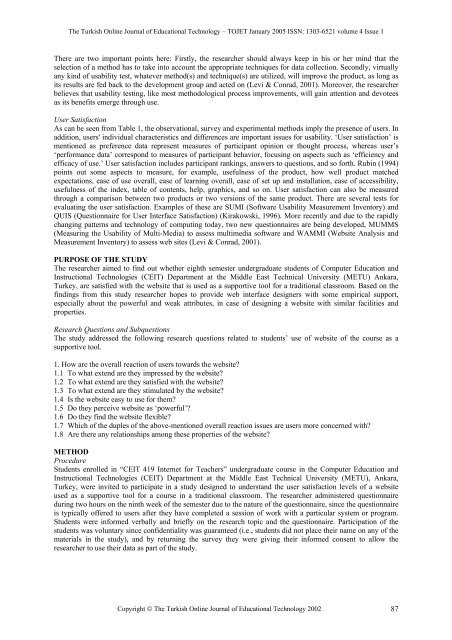Age - TOJET the Turkish online journal of educational technology
Age - TOJET the Turkish online journal of educational technology
Age - TOJET the Turkish online journal of educational technology
Create successful ePaper yourself
Turn your PDF publications into a flip-book with our unique Google optimized e-Paper software.
The <strong>Turkish</strong> Online Journal <strong>of</strong> Educational Technology – <strong>TOJET</strong> January 2005 ISSN: 1303-6521 volume 4 Issue 1<br />
There are two important points here: Firstly, <strong>the</strong> researcher should always keep in his or her mind that <strong>the</strong><br />
selection <strong>of</strong> a method has to take into account <strong>the</strong> appropriate techniques for data collection. Secondly, virtually<br />
any kind <strong>of</strong> usability test, whatever method(s) and technique(s) are utilized, will improve <strong>the</strong> product, as long as<br />
its results are fed back to <strong>the</strong> development group and acted on (Levi & Conrad, 2001). Moreover, <strong>the</strong> researcher<br />
believes that usability testing, like most methodological process improvements, will gain attention and devotees<br />
as its benefits emerge through use.<br />
User Satisfaction<br />
As can be seen from Table 1, <strong>the</strong> observational, survey and experimental methods imply <strong>the</strong> presence <strong>of</strong> users. In<br />
addition, users' individual characteristics and differences are important issues for usability. ‘User satisfaction’ is<br />
mentioned as preference data represent measures <strong>of</strong> participant opinion or thought process, whereas user’s<br />
‘performance data’ correspond to measures <strong>of</strong> participant behavior, focusing on aspects such as ‘efficiency and<br />
efficacy <strong>of</strong> use.’ User satisfaction includes participant rankings, answers to questions, and so forth. Rubin (1994)<br />
points out some aspects to measure, for example, usefulness <strong>of</strong> <strong>the</strong> product, how well product matched<br />
expectations, ease <strong>of</strong> use overall, ease <strong>of</strong> learning overall, ease <strong>of</strong> set up and installation, ease <strong>of</strong> accessibility,<br />
usefulness <strong>of</strong> <strong>the</strong> index, table <strong>of</strong> contents, help, graphics, and so on. User satisfaction can also be measured<br />
through a comparison between two products or two versions <strong>of</strong> <strong>the</strong> same product. There are several tests for<br />
evaluating <strong>the</strong> user satisfaction. Examples <strong>of</strong> <strong>the</strong>se are SUMI (S<strong>of</strong>tware Usability Measurement Inventory) and<br />
QUIS (Questionnaire for User Interface Satisfaction) (Kirakowski, 1996). More recently and due to <strong>the</strong> rapidly<br />
changing patterns and <strong>technology</strong> <strong>of</strong> computing today, two new questionnaires are being developed, MUMMS<br />
(Measuring <strong>the</strong> Usability <strong>of</strong> Multi-Media) to assess multimedia s<strong>of</strong>tware and WAMMI (Website Analysis and<br />
Measurement Inventory) to assess web sites (Levi & Conrad, 2001).<br />
PURPOSE OF THE STUDY<br />
The researcher aimed to find out whe<strong>the</strong>r eighth semester undergraduate students <strong>of</strong> Computer Education and<br />
Instructional Technologies (CEIT) Department at <strong>the</strong> Middle East Technical University (METU) Ankara,<br />
Turkey, are satisfied with <strong>the</strong> website that is used as a supportive tool for a traditional classroom. Based on <strong>the</strong><br />
findings from this study researcher hopes to provide web interface designers with some empirical support,<br />
especially about <strong>the</strong> powerful and weak attributes, in case <strong>of</strong> designing a website with similar facilities and<br />
properties.<br />
Research Questions and Subquestions<br />
The study addressed <strong>the</strong> following research questions related to students’ use <strong>of</strong> website <strong>of</strong> <strong>the</strong> course as a<br />
supportive tool.<br />
1. How are <strong>the</strong> overall reaction <strong>of</strong> users towards <strong>the</strong> website?<br />
1.1 To what extend are <strong>the</strong>y impressed by <strong>the</strong> website?<br />
1.2 To what extend are <strong>the</strong>y satisfied with <strong>the</strong> website?<br />
1.3 To what extend are <strong>the</strong>y stimulated by <strong>the</strong> website?<br />
1.4 Is <strong>the</strong> website easy to use for <strong>the</strong>m?<br />
1.5 Do <strong>the</strong>y perceive website as ‘powerful’?<br />
1.6 Do <strong>the</strong>y find <strong>the</strong> website flexible?<br />
1.7 Which <strong>of</strong> <strong>the</strong> duples <strong>of</strong> <strong>the</strong> above-mentioned overall reaction issues are users more concerned with?<br />
1.8 Are <strong>the</strong>re any relationships among <strong>the</strong>se properties <strong>of</strong> <strong>the</strong> website?<br />
METHOD<br />
Procedure<br />
Students enrolled in “CEIT 419 Internet for Teachers” undergraduate course in <strong>the</strong> Computer Education and<br />
Instructional Technologies (CEIT) Department at <strong>the</strong> Middle East Technical University (METU), Ankara,<br />
Turkey, were invited to participate in a study designed to understand <strong>the</strong> user satisfaction levels <strong>of</strong> a website<br />
used as a supportive tool for a course in a traditional classroom. The researcher administered questionnaire<br />
during two hours on <strong>the</strong> ninth week <strong>of</strong> <strong>the</strong> semester due to <strong>the</strong> nature <strong>of</strong> <strong>the</strong> questionnaire, since <strong>the</strong> questionnaire<br />
is typically <strong>of</strong>fered to users after <strong>the</strong>y have completed a session <strong>of</strong> work with a particular system or program.<br />
Students were informed verbally and briefly on <strong>the</strong> research topic and <strong>the</strong> questionnaire. Participation <strong>of</strong> <strong>the</strong><br />
students was voluntary since confidentiality was guaranteed (i.e., students did not place <strong>the</strong>ir name on any <strong>of</strong> <strong>the</strong><br />
materials in <strong>the</strong> study), and by returning <strong>the</strong> survey <strong>the</strong>y were giving <strong>the</strong>ir informed consent to allow <strong>the</strong><br />
researcher to use <strong>the</strong>ir data as part <strong>of</strong> <strong>the</strong> study.<br />
Copyright © The <strong>Turkish</strong> Online Journal <strong>of</strong> Educational Technology 2002 87
















